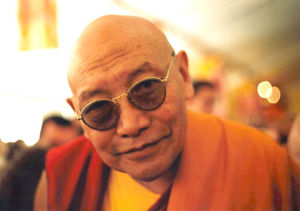Trulshik Rinpoche: Difference between revisions
No edit summary |
|||
| Line 9: | Line 9: | ||
Trulshik Rinpoche is also the unique heir to some of Tibet's rarer traditions, for instance that of the "Pacification of Suffering" (Tib. [[Shyijé]]), first introduced in Tibet during the 11th century by the Indian yogin [[Padampa Sangye]]. As the present embodiment of a line of treasure-discoverers, he continues his predecessor's teachings, especially those in relations to the great master [[Padmasambhava]] and the meditational teachings of the Great Perfection or [[Dzogchen]]. Trulshik Rinpoche's unusually clear and spontaneous style of teaching is reflected in his accomplishments as a poet and master of all aspects of the monastic arts. His direction of the annual Mani Rimdu festival of masked dance-drama is documented in Richard Kohn's film Lord of the Dance, Destroyer of Illusion (1986), the title of which is in part derived from his name, Trulshik Rinpoche, "the Precious Destroyer of Illusion." | Trulshik Rinpoche is also the unique heir to some of Tibet's rarer traditions, for instance that of the "Pacification of Suffering" (Tib. [[Shyijé]]), first introduced in Tibet during the 11th century by the Indian yogin [[Padampa Sangye]]. As the present embodiment of a line of treasure-discoverers, he continues his predecessor's teachings, especially those in relations to the great master [[Padmasambhava]] and the meditational teachings of the Great Perfection or [[Dzogchen]]. Trulshik Rinpoche's unusually clear and spontaneous style of teaching is reflected in his accomplishments as a poet and master of all aspects of the monastic arts. His direction of the annual Mani Rimdu festival of masked dance-drama is documented in Richard Kohn's film Lord of the Dance, Destroyer of Illusion (1986), the title of which is in part derived from his name, Trulshik Rinpoche, "the Precious Destroyer of Illusion." | ||
==Internal Links== | ==Internal Links== | ||
*[[Prayer for the Long Life of Trulshik Rinpoche by His Holiness the Dalai Lama]] | |||
*[[Trulshik Rinpoche's Lineage of Nyingtik Yabshyi]] | *[[Trulshik Rinpoche's Lineage of Nyingtik Yabshyi]] | ||
Revision as of 09:06, 29 July 2008
Kyabjé Trulshik Rinpoche Ngawang Chökyi Lodrö ('khrul zhig ngag dbang chos kyi blo gros), was born at Yardrok Taklung in Central Tibet in 1923.

He was recognized in early childhood as the immediate re-embodiment of Tertön Do-ngak Lingpa (Kunzang Thongdrol Dorje) a famous discoverer of spiritual treasures and is also considered as being the manifestaion of Lord Buddha’s disciple Ananda, as well as of Aryadeva, Thönmi Sambhota, the abbot Shantarakshita, the translator Vairotsana and Rechung Dorje Trakpa.
He received his early education from his predecessor's foremost disciple, Ngawang Tendzin Norbu (1867-1942), who was known as the Buddha of Dza Rongphuk after his place of retreat and the monastery that he established on the northern slopes of Mount Everest. After Ngawang Tendzin Norbu passed away, Trulshik Rinpoche became the abbot of the monastic community, and following the tragic events of 1959 moved with his followers to safe haven in the valleys to the south of the Mount Everest area, among the Sherpa people of northeastern Nepal. Thupten Chöling, the monastery that he founded there, is today renowned as a foremost center for the monastic traditions of the Nyingma School of Tibetan Buddhism. Since he came out of Tibet, Rinpoche has ordained nearly ten thousand monks and nuns.
Besides his root-guru, Trulshik Rinpoche's teachers have included Minling Chung Rinpoche and Dordzin Rinpoche, Dudjom Rinpoche, Jamyang Khyentse Chökyi Lodrö and especially Dilgo Khyentse Rinpoche of whom he was like a heart-son. Altogether he had some fifty masters representing all of the major lineages of Tibetan Buddhism. Over the years, he has also been offering many rare Nyingma teachings to His Holiness the Dalai Lama.
Trulshik Rinpoche is also the unique heir to some of Tibet's rarer traditions, for instance that of the "Pacification of Suffering" (Tib. Shyijé), first introduced in Tibet during the 11th century by the Indian yogin Padampa Sangye. As the present embodiment of a line of treasure-discoverers, he continues his predecessor's teachings, especially those in relations to the great master Padmasambhava and the meditational teachings of the Great Perfection or Dzogchen. Trulshik Rinpoche's unusually clear and spontaneous style of teaching is reflected in his accomplishments as a poet and master of all aspects of the monastic arts. His direction of the annual Mani Rimdu festival of masked dance-drama is documented in Richard Kohn's film Lord of the Dance, Destroyer of Illusion (1986), the title of which is in part derived from his name, Trulshik Rinpoche, "the Precious Destroyer of Illusion."
Internal Links
- Prayer for the Long Life of Trulshik Rinpoche by His Holiness the Dalai Lama
- Trulshik Rinpoche's Lineage of Nyingtik Yabshyi